Your salmon farmer
From egg to plate
It takes a dedicated team of passionate professionals to care for our fish from egg through to plate.
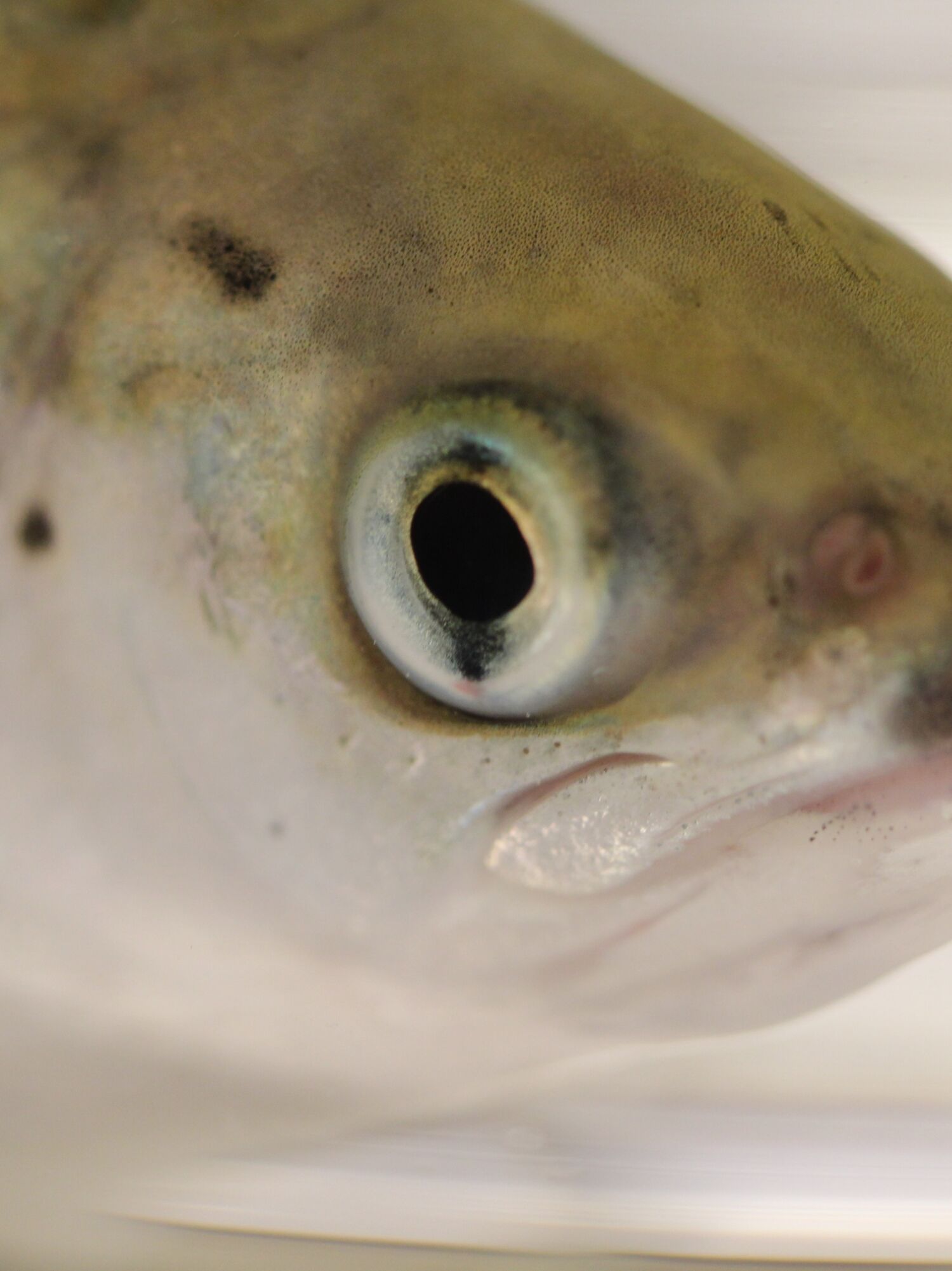
We farm delicious, sustainable Atlantic salmon to provide people with a healthy and nutritious protein that they can be proud to serve their family.
Getting from egg to plate takes a team of dedicated professionals for every stage of the journey. In salmon farming, we mimic the natural lifecycle of Atlantic salmon as closely as possible to ensure healthy and happy fish.
Lets take a brief look at what it takes to raise our salmon, and get them from egg to plate.
Broodstock - the start of the next generation of our fish
Our broodstock represents the history and the future of our company. Our Freshwater team includes geneticists who specializes in selecting healthy fish which grow well, without maturing too early (called gryls), and that react well to handling, show resistance to disease, and during harvest, provide a high quality of meat.
We use those fish as our broodstock – or the parents – of the next generation. By carefully selecting for these traits, we can help improve the overall health and welfare of our fish by increasing resistance to known pathogens and reducing the stress they experience during handling. Some of the broodstock live in ocean farms, while others spend their entire lives in fresh water at our hatchery facilities.
Both fish – those that spend the second portion of their lives in salt water, and those that spend their entire life cycle in freshwater, perform well. Broodstock are split between fresh and salt water locations to help minimize the risk if we were to lose one whole population.
As our broodstock fish approach maturity, they are monitored closely by employees and given regular ultrasounds to check for the readiness of their eggs. Once they are ready, the fish are humanely euthanized using a clove-oil based product, then the eggs and milt are collected. The eggs are fertilized by mixing the milt and eggs in large containers. Once they milt and eggs have combined, the fertilized eggs are placed into egg trays, which simulate natural spawning conditions by maintaining a constant flow of fresh water through the trays and over the eggs.
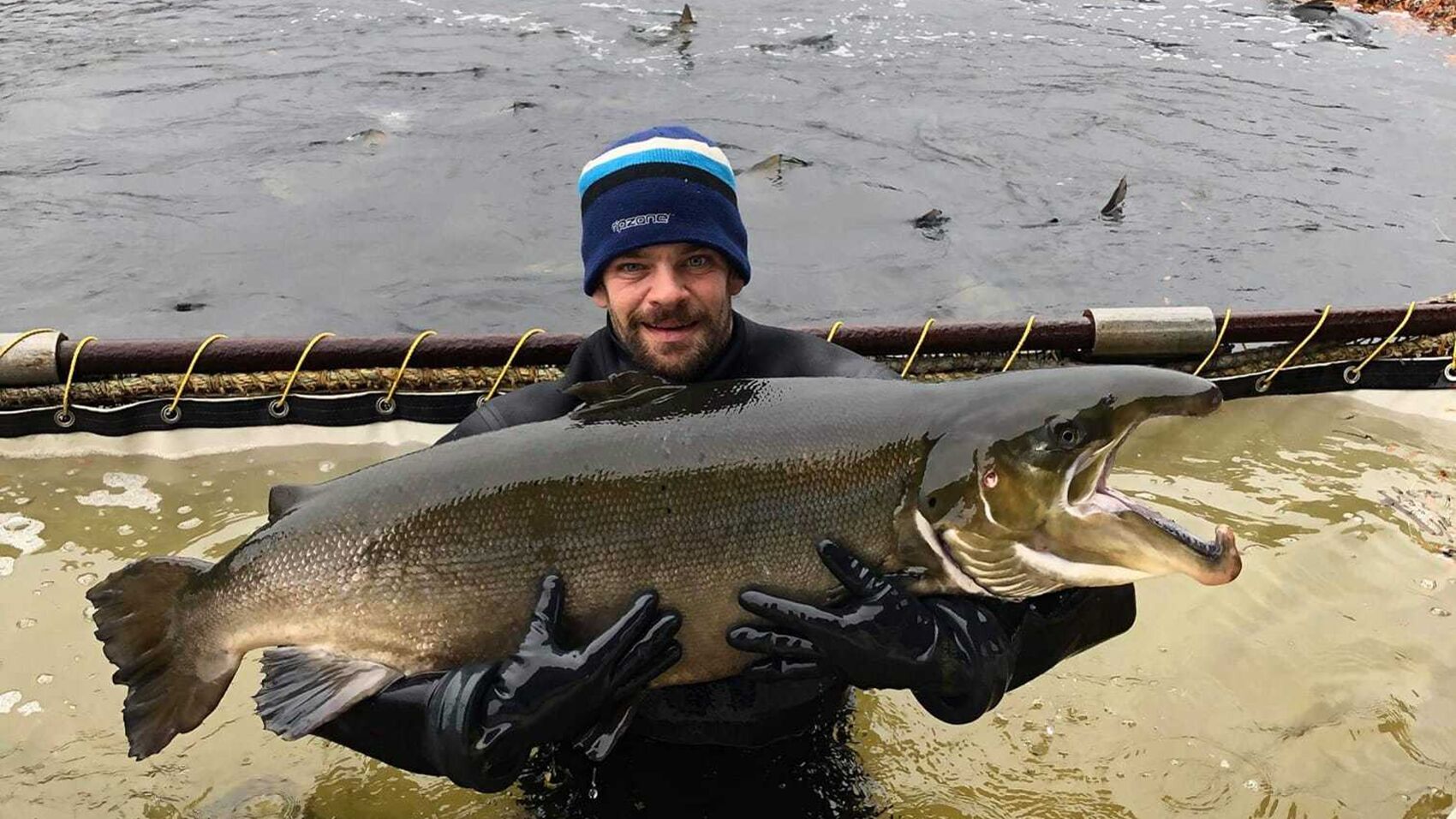
Next up - freshwater hatcheries
This is when things really start to get exciting. The eggs are monitored daily for development, health and signs of disease. Eggs that are developing normally will now have a prominent “eye”, which is the first sign that the egg has been successfully fertilized and is developing normally.
Although very rare, eggs can contract various bacteria or viruses that can come in through the fresh water supply. The water is treated and filtered several times before coming into contact with the eggs using UV lighting and ozone treatment. In the rare occurrence that some bacteria does enter the system, we have a few treatment options. We can increase the salinity very slightly as freshwater pathogens don’t do well in salt water, but does not harm the eggs. We can also use medication to treat the eggs such as Formalin which is an antibacterial, or we can use a very diluted (less that one percent concentrate) solution of hydrogen peroxide.
Monitoring of the eggs used to be completed by hand and involved employees painstakingly sorting through racks and racks of eggs to spot and remove individual unfertilized or unhealthy eggs. When you have up to six million eggs in a hatchery, this can take a while. We now have egg-sorting machines that use laser and photo technology to sort through up to 36 eggs per second, and separate out the good eggs from the bad eggs with a very high rate of accuracy.
As the eggs develop, they are transferred to specialized trays created for the next stage of the life cycle - alevin. These racks allows the water to continue to move through as it would in a natural spawning habitat, but provide fingers for the young alevin to rest in-between.
Alevin have a yolk sac which provides all of their energy and nutritional requirements. The alevin are quite fragile at this stage, so by minimizing their movement and allowing them to conserve energy, we are helping them to develop into strong, healthy fish.
From alevin, our tiny salmon progress to the fry stage and are becoming more easily identifiable as Atlantic salmon. They are moved from the specially designed trays into large, recirculating tanks.
At this stage, the fry are introduced to pellet feeding. The fish will eat these pellets throughout their life, but the size and nutritional content will change depending on their size and stage of development.
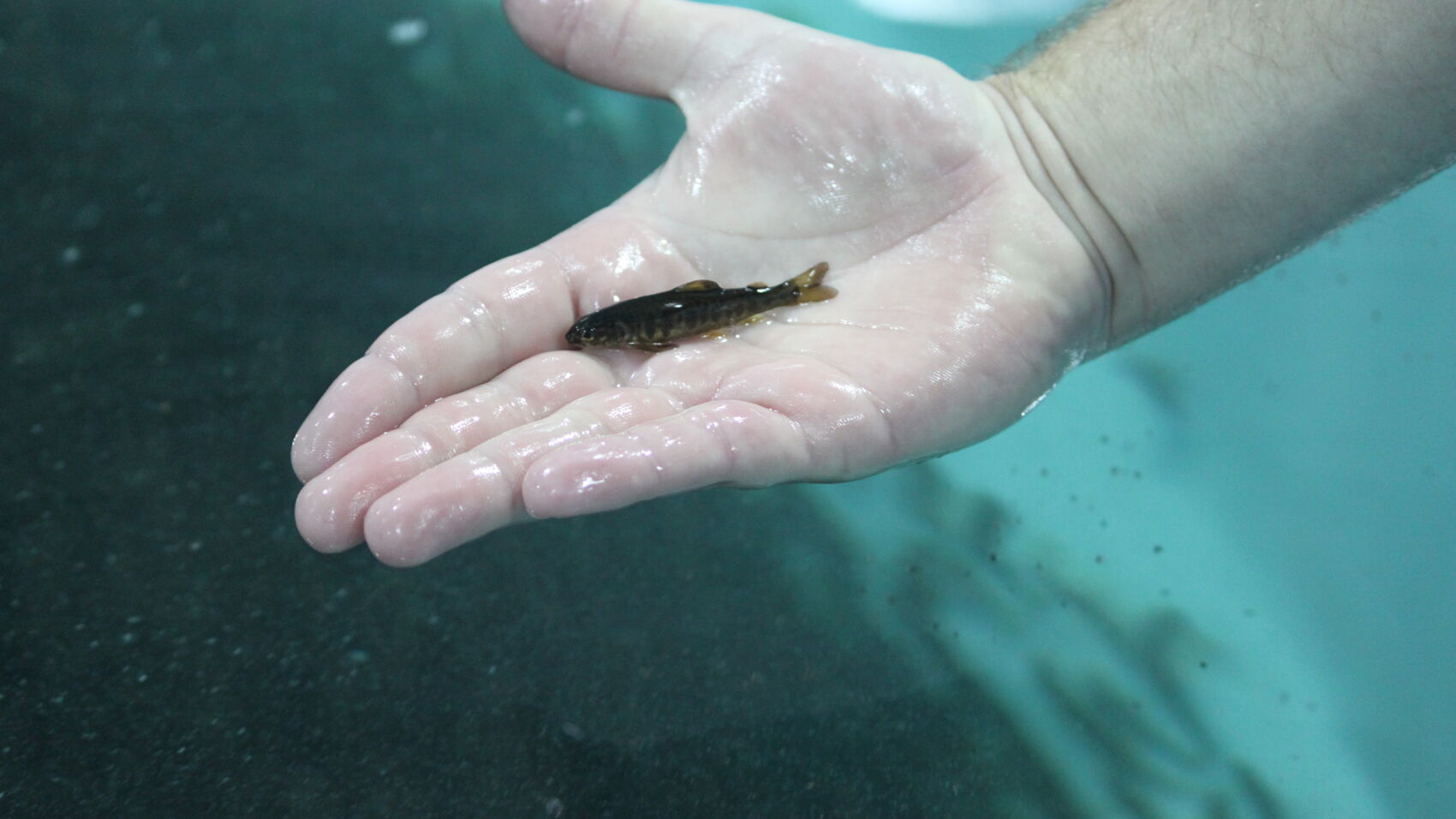
As the fish continue to grow and develop, they enter the smolt phase of their lifecycle. At this point, the fish are moved from the smaller indoor tanks, to large outdoor recirculating tanks at our hatcheries. The tanks are covered by thick, light-blocking tarps. Aside from preventing the smolts from becoming an eagle and racoon smorgasbord, the tarps also help us get the fish ready for their next life stage – called “smoltification.”
Smoltification. Yes, that is a real thing.
In nature, wild salmon spend the first winter in fresh water – growing, eating and getting ready for their out-migration which happens every spring starting in March and usually ending in late June.
Because our smolts are kept in a light and temperature controlled environment, we have the ability to use lighting and water temperature as tools to coax the fish into believing they have gone through a dark winter. By gradually increasing the amount of light they are exposed to in a day, we can coax the fish into believing they are approaching spring.
This practice is important to our business model as it allows us to grow fish year round, instead of having large smolt transfers each spring, with a large harvest in late summer.
During smoltification, the fish begin to show physiological changes as they begin to prepare for the migration from fresh to saltwater. Their scales start to become a light silvery colour, and their fins become lighter in colour and more translucent. Even their blood chemistry changes as they prepare their body to move from fresh to salt water.

Getting our fish ready for transport to our ocean farms
Before we transport to our sea sites, we perform our last rigorous health and welfare screening to ensure they are healthy, disease-free and ready for transport. During this exam, the smolts are sorted by size and placed into large, temperature controlled transport tanks.
By sorting our fish by size, we are ensuring that the feed to fish ration will be as efficient as possible and will be equally dispersed across the farm pen population. As the say, the early bird gets the worm, and in our case, the big fish get the feed pellets.
Our fish leave the hatchery and enter our ocean farm sites healthy, and free from disease and parasites. This seems to be a common misconception but in order to receive clearance from our regulators and our internal fish health team, the fish must be healthy, disease-free and showing signs of advanced smoltification before they can be transported to our farms. It is also important to note that sea lice live in saltwater, not fresh, making it impossible for our fish to enter the ocean with any sea lice.
The transport tanks are temperature controlled and have a filtration system to ensure the fish are continuing to receive oxygen and that their waste is being removed.
The smolts are loaded into the transport tanks, which are then loaded onto flatbed trailers. They are then transported to a wharf close to the farm site. From there, they are loaded onto a barge and transported to a farm site to be stocked.
In total, completing the sorting loading and transporting of our fish to either the west or east coast of Vancouver Island can usually be accomplished in less than 24 hours. The idea is to sort, load, transport and then stock our farms as quickly as possible to minimize the stress on our fish.
Life at sea
Once at the farm sites, the smolts are entered into the ocean pens. One farm can accommodate up to 800,000 fish depending on the farm licence – with room to spare. In our farming set up, fish only account for two percent of the volume in each pen. Salmon travel in a school, which can lead to the appearance of crowding, but they are just doing what salmon naturally do, which is school together for safety.
The health and growth of our fish is the main priority now as fish are left to swim, eat and grow.
Our employees continuously monitor our fish for health, disease and growth.
Fish will typically spend between 18 and 24 months at the ocean farm before reaching 5.5 kilograms – which is the size at which we begin to harvest our fish.
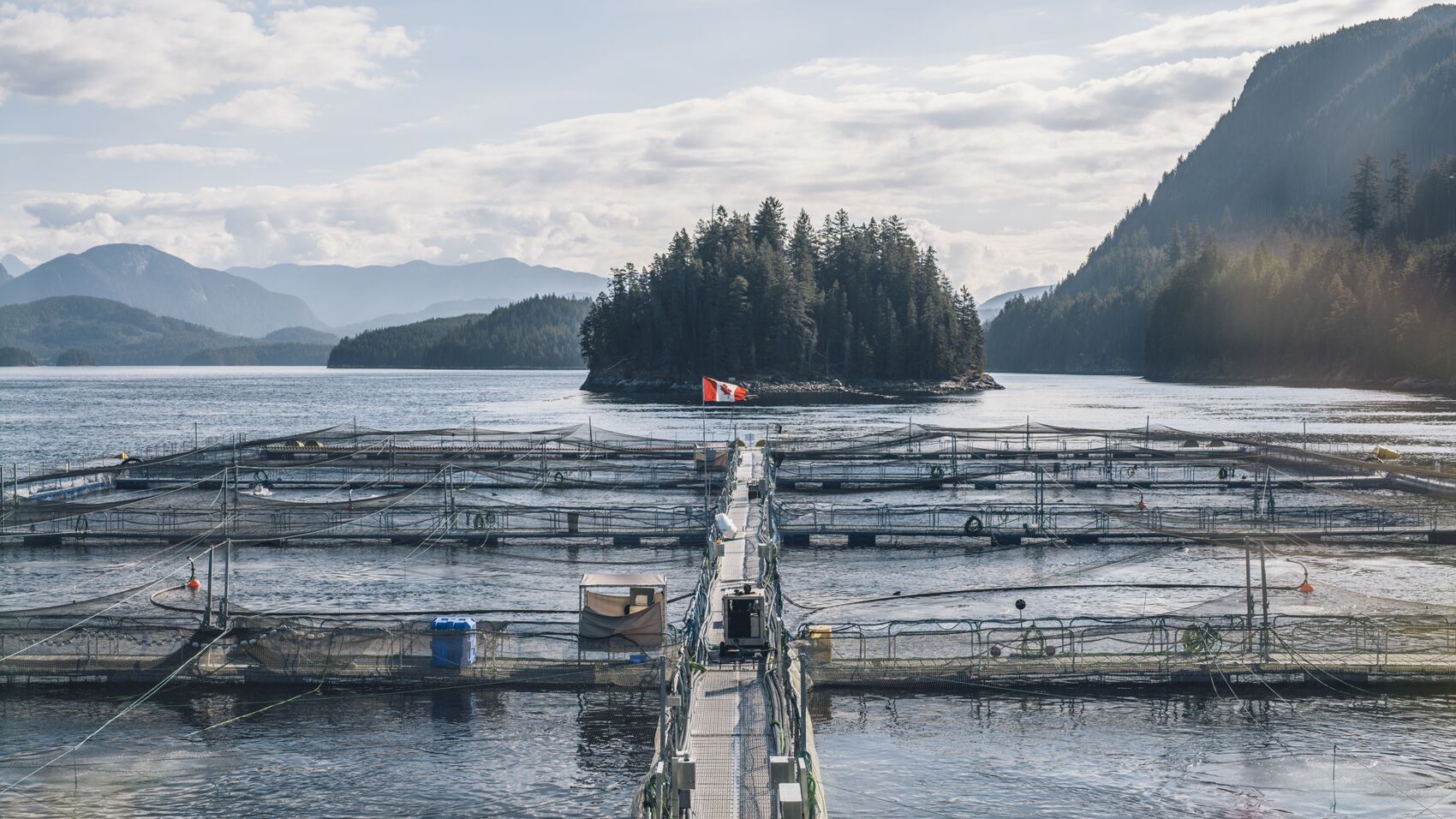
Harvesting, where the next stage of the story begins.
By the time the fish reach the point where we are ready to start harvesting, we have spent between three and a half to four years caring for every single fish. We have seen them grown from an egg the size of a small pea, to a large (5.5 kilogram), beautiful, healthy fish. We are pretty invested – financially and emotionally – so we approach harvesting as we approach all of our operations, with fish welfare top of mind.
To begin the process, a grading seine is placed into the pen selected for harvest. The seine is a large net which hangs into the pen and allows smaller fish to pass through, creating a natural separation between the largest fish and the rest of the pen population.
We harvest our largest fish first and repeat the process for each of the farm’s pens until all of the fish have been harvested. Harvesting our fish from each site can range from weeks to months as we monitor growth, development and farm conditions throughout the process.
To harvest our fish, we contract with local harvest boat owners and operators. These specialized boats are fully automated and designed to ensure the fish are harvested in a low-stress and humane manner.
Our employees help the harvest boat crews by gathering the selected fish into a smaller area by pulling the slack from the seine net. From there, the selected fish are drawn into the harvest boat using gentle suction.
Once inside the boat, the fish are stunned and then quickly and humanely bled and packed on ice. The process from the time the fish enters the harvester, to the point when they are stunned in less than a minute creating very little stress for the fish.
Harvest boast have a capacity of about 14,000 fish, while each of our pens can hold up to 50,000 fish depending on the location and the licence. Once full, the boat immediately travels to the closest processing plant and delivers the fish for the next stage of the journey from egg to plate.
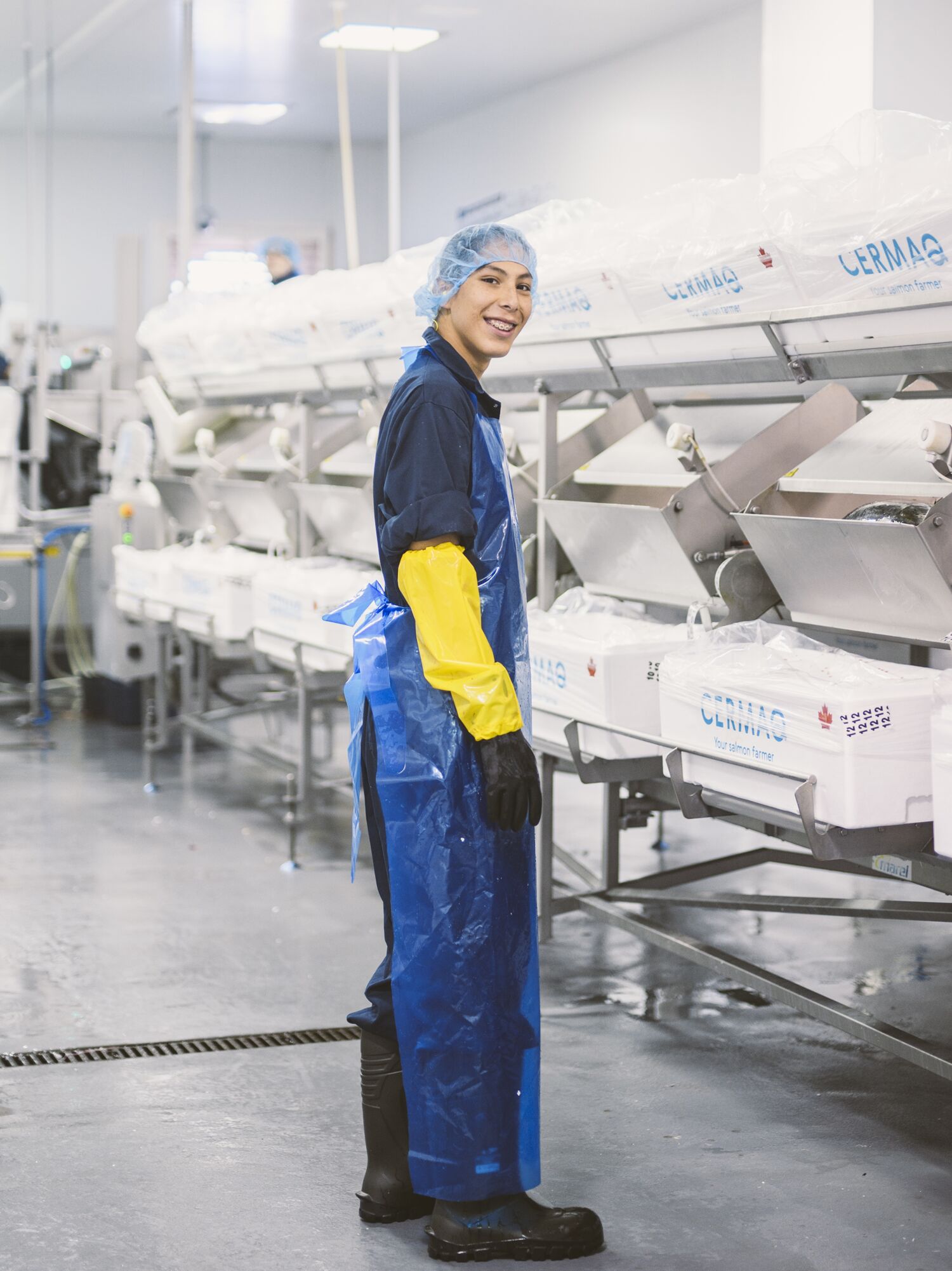
Processing
Our fish are transported from our farms to our processing plants by harvest boat. We have one plant in Tofino for our operations on the west coast of Vancouver Island, and we contract with a processing facility near Campbell River for our operations on the east coast of Vancouver Island.
Once the boat arrives, the fish are unpacked and entered into the processing facility where they are gutted, rated for quality, measured, weighed and packed into transportation coolers.
We are very proud of the quality of our fish. We sell over 98 per cent of our fish (98%) in the premium classification. This is a reflection of the care we provide for our fish – from egg to plate. By using the best feeds available, providing excellent animal welfare and ensuring our fish performing well through daily water testing, sampling and using area-based management, we have some of the healthiest and most delicious fish on the market.
From the time the fish is harvested, until it is processed, packed and ready for shipment is generally less than 12 hours. This helps to ensure our customers are receiving the freshest salmon possible.
At Cermaq, we sell our fish as whole, head-on salmon. Our customers are large fish markets, restaurants and grocery chains. Currently, we don’t sell directly to consumers but are proud that the fish we grow are being enjoyed by families and individuals around the globe.